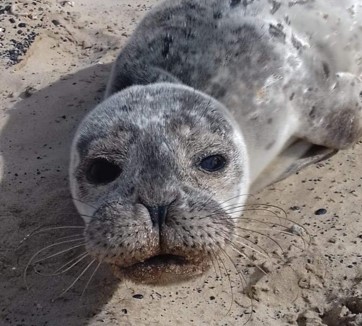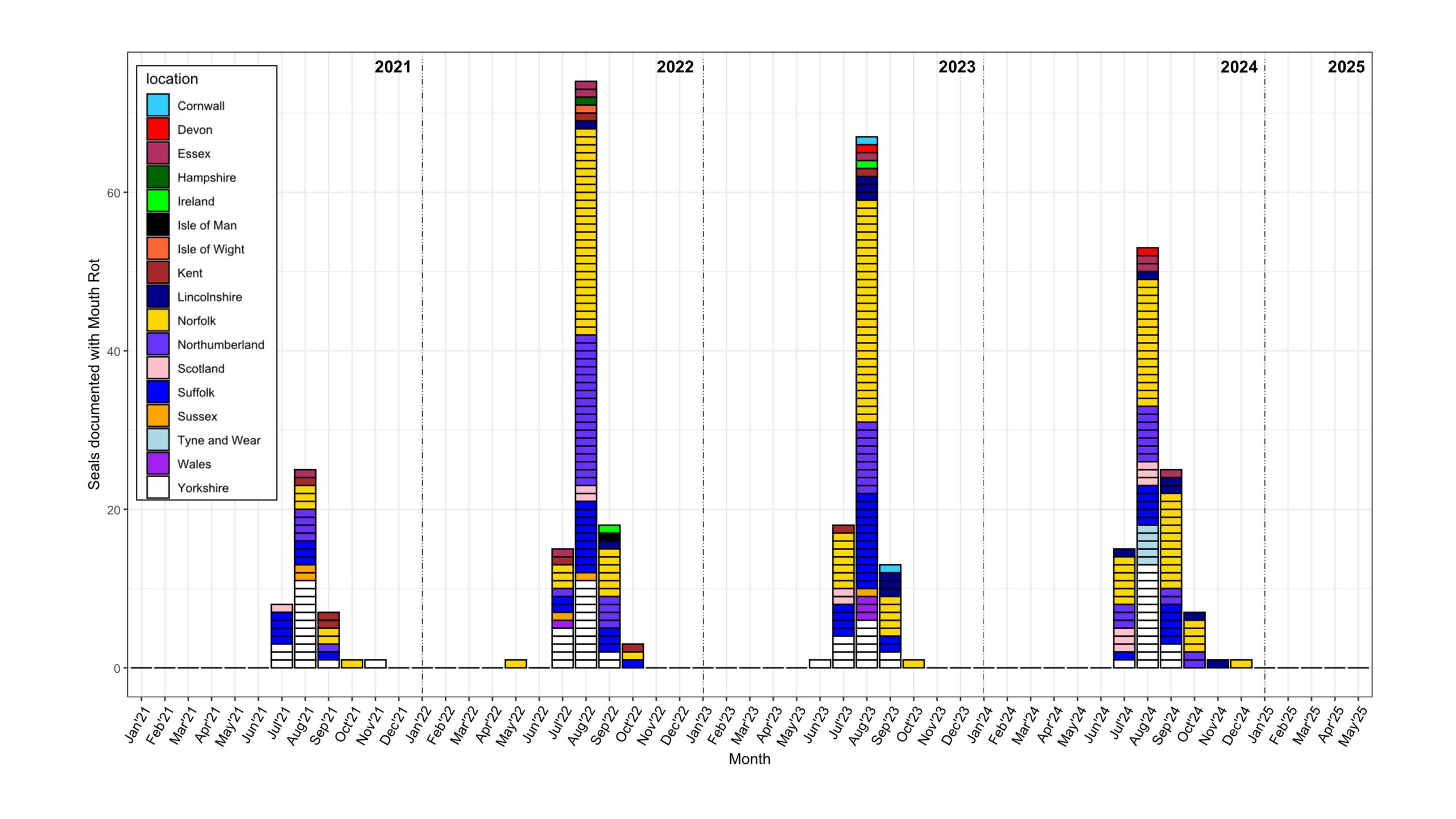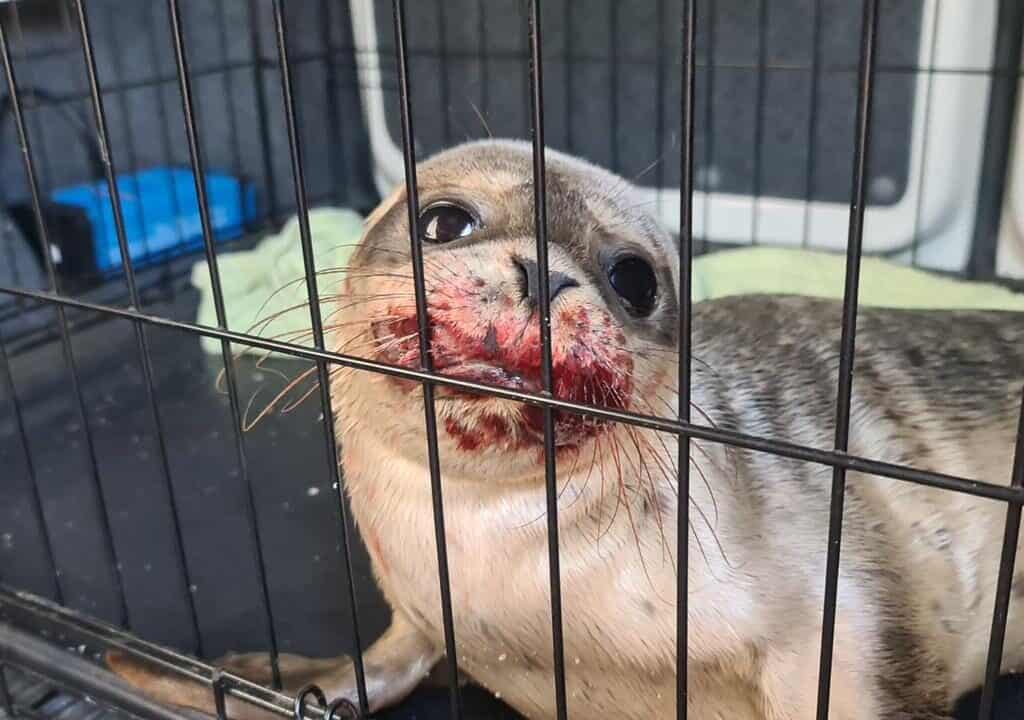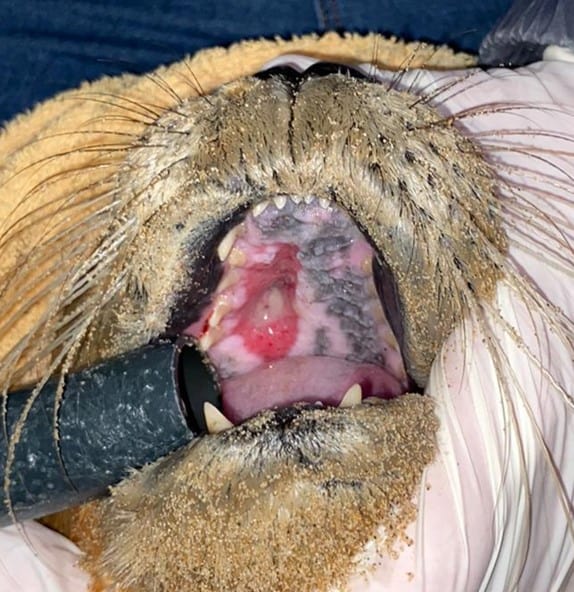
*Please note: graphic images below*
British Divers Marine Life Rescue is currently part of a collaborative effort to investigate an outbreak of disease in common seals known as ‘mouth rot’.
What is mouth rot?
Mouth rot is a condition that affects the mouths of newly weaned common seal pups. Pups can experience muzzle swelling, facial wounds and abscesses, and ulceration of the hard palate (roof of the mouth). These ulcerations can become very severe, have serious impacts on the pup’s health and welfare, and ultimately result in their death.
Why are we investigating?
Although cases of mouth rot have been identified in weaned common seal pups for many years, a recent upward trend in the number and severity of cases prompted an investigation to begin. There is obvious concern not only for the welfare of these seals, but also potentially for their conservation in the affected areas.
What are the aims of the investigation?
As a result of our work we hope to identify the cause of this condition and attempt to understand why case numbers have increased, how to better care for affected pups in rehabilitation, and whether it poses a threat to common seal conservation – and if it does, if there is anything that can be done to help manage the condition.
The investigation so far…
Mouth rot was first raised as a concern during the 2020 common seal pupping season, leading to a small number of samples being taken and processed- the results then prompted a structured investigation to begin the following year.
During the 2021, 2022, 2023 and 2024 common seal pupping seasons, information about each observed case of mouth rot was recorded and samples from pups that were euthanased due to the severity of their condition were collected for analysis. Samples are being processed by Dr Jamie Bojko at the National Horizons Centre, Teesside University, with support from ZSL, CSIP and DEFRA. Our overall aim initially is to investigate whether this condition has a viral and/or bacterial component to its cause.
The results so far suggest that this is a condition seen in weaned common seal pups, with a peak in cases in August each year (unusually, in 2024, we also noted significantly more cases than usual in September). Most cases have been reported on the east coast of England, with Norfolk seen as the ‘busiest’ region for suspect cases- and other ‘busy’ regions including Northumberland, Suffolk, and Yorkshire. However, small numbers of cases have also been observed as far away as in areas of Scotland, Ireland, and the south-west of England. In one instance, a yearling was found with the pathology (May, 2022), which was recurrent after it survived mouth rot as a pup.
The graph below shows the number of mouth rot cases reported in each region, during each month of the 2021-2024 seasons.

Around 30-40% of common seal callouts attended by BDMLR (calls which resulted in the seal being examined) involved seal pups with signs of mouth rot. Of those pups with mouth rot signs, around 40-50% had more severe disease, with bone exposure on the roof of the mouth due to the depth of the ulceration.
The table below outlines the number of callouts BDMLR received to common seals during each year from 2021 to 2024. It also lists the number of calls attended- that’s the proportion of overall callouts that were attended by a BDMLR Medic, and the seal was able to be assessed. The bottom row lists the number of these attended calls that were pups with signs of mouth rot. For example, in the final column, we can see that BDMLR received 540 callouts involving common seals in 2024, of those, 261 were attended, and of those, 101 (39%) had signs of mouth rot.

We know that pups in earlier stages of the condition can recover well and go on to be released, but where there are large areas of exposed bone- and where the bone has become infected and died- the prognosis is much poorer.
At the lab, samples are screened for the presence pathogens using a general genomic approach (searching for the genetic material of pathogens such as viruses and bacteria).
Fifty-five samples from affected common seals have been processed in the lab to date. To date, a number of viral and bacterial species have been identified, but the difficulty is now in trying to determine which (if any) of these candidates may be involved with the disease we are seeing. At present the suspicion is that mouth rot is the result of a complex, combined viral and bacterial infection, with multiple pathogens involved. Work is ongoing to help further define the pathology that we are seeing (via histopathological and molecular techniques), to help us better understand the nature and progression of this disease. Data and sample collection will continue through the common seal rescue seasons, and work in the lab will continue to progress behind the scenes to help us narrow down who the key pathogens are.
How can you help?
Members of the public
If you find a seal pup whose welfare you are concerned for, then make sure to give them plenty of space and keep dogs under control on a lead to avoid disturbing them, and don’t touch or try to move them into the sea. Please call the BDMLR hotline on 01825 765546 for advice and assistance.
Rehabilitation staff and veterinary practitioners
If you work with seals in a rehabilitation and/or veterinary capacity in the UK or elsewhere in Europe, you may be able to assist us! If you see any seal pups, regardless of species, presenting to you with a swollen muzzle, facial wounds (particularly around the lips) or hard palate lesions, such as those in the photos at the end of this article, please get in touch via our project email address below. We will allocate you a research number for the pup; ask you to complete the data collection form; and require photos to complete the dataset. If the pup is deceased then samples can be taken and sent to us for analysis – the protocol is at the bottom of the data collection form that can be downloaded at the end of this article. Crucially, we are also looking to record information on how these pups respond to attempted treatment, and what their eventual outcome is. We would be very grateful if rehabilitation centres would be willing to share this information (again, via the project email address).
BDMLR Marine Mammal Medics
BDMLR volunteers are an essential part of this investigation, working to identify pups with mouth rot and record the critically important information needed about each pup. Due to the nature of mouth rot case distribution, volunteers on the east coast are most likely to be involved with the project. Information about the condition and data collection protocol will be shared internally within BDMLR and any questions can be sent to the project team at the email address below or via Head Office.
A note on grey seals: although grey seal pups will commonly present with oral conditions such as gingivitis/stomatitis, as of yet we have no evidence to suggest that they are presenting in a similar way to the common seal pups with mouth rot. If anyone comes across a grey seal pup with signs suspicious of mouth rot then please take photos and send them to our project email address below so that we can review them and advise further. To speak to a member of the team then contact the Hotline Coordinator on 01825 765546.
Contact us.
If you have a query about the project or would like to send any completed data collection forms and photos, please email us at mouthrotproject@bdmlr.org.uk or call on 01825 765546.
Resources.
Download our data collection form and sampling protocol (can be completed digitally or printed)
Download further information for veterinary practices
Download further information for rehabilitation centres
Thanks.
We would like to give thanks to our partners at the University of Teesside and the Cetacean Strandings Investigation Programme for their contributions to the project so far, and to the Department of Environment Food and Rural Affairs who are funding this work.
Thank you also to all of the BDMLR volunteers, veterinary staff, and rehabilitation centre staff who are involved with data collection and sampling efforts. Without their hard work this project would not be possible!


